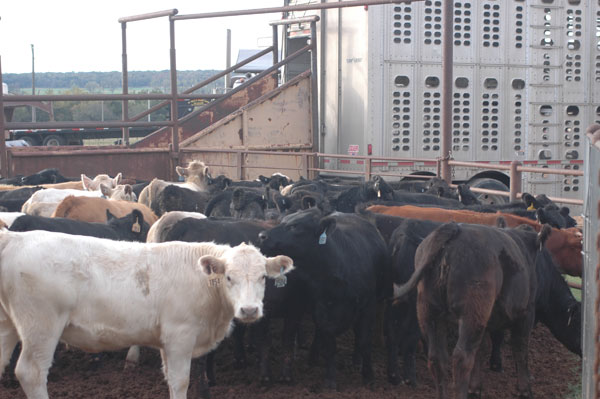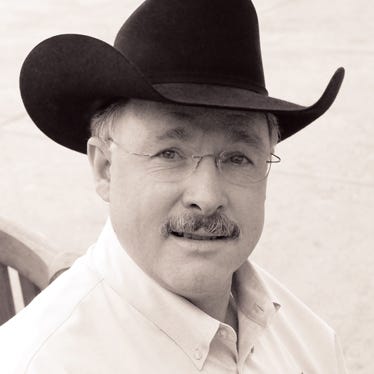Lighter carcass weights continue supporting market
Calf and feeder cattle prices traded steady to either side of even, while fed cattle prices looked to take a step higher.
February 23, 2019

Demand for calves and feedlot replacements was tempered this week by tough pen conditions, with another belt of snow aiming for Kansas, Nebraska and Iowa.
Steers and heifers sold from $1 per cwt lower to $2 higher across much of the nation, according to the Agricultural Marketing Service (AMS). Prices in the Southeast were steady to $4 lower.
“Cattle feeders were on the defensive after another snowstorm early in the week, with more on the way,” said the AMS reporter on hand for Thursday’s sale at Mitchell Livestock Auction in South Dakota. “Much colder than normal temps for the last 30 days, coupled with snow and high winds, has made for a really tough winter. Cattle performance has suffered, which increased costs of gain.”
Week to week on Friday, Feeder Cattle futures closed an average of 54 cents higher (7 to 90 cents higher).
“Cow-calf operators and backgrounders will likely see lower prices during 2019 on a combination of higher feed prices, expected large supplies of cattle in feedlots and adequate supplies of calves available for placement,” said Shayle Shagam, livestock analyst with USDA’s World Agricultural Outlook Board, at this week’s Agricultural Outlook Forum.
“With continued large supplies of cattle in feedlots and a slower expected pace of placements in early 2019, feeder steer prices in first-half 2019 were lowered, bringing the annual price forecast down to $140-$149 per cwt, with a midpoint price of $144.50 per cwt.,” say analysts with USDA’s Economic Research Service (ERS), in the February Livestock, Dairy and Poultry Outlook (LDPO)—the first since December due to the government shutdown.
Part of the pressure stems from unrealized expectations for improved Southern Plains winter wheat pasture last fall to absorb increased seasonal supplies of cattle.
“Based on weekly data from the National Feeder and Stocker Cattle Summary, there were about 1% more calves sold in 2018 than in 2017. This was particularly true in fourth-quarter 2018, where about 7% more calves were sold than for the same period in 2017,” ERS analysts say. “However, in late 2018, feedlots’ pace of marketings slowed more than expected. The large numbers of cattle in feedlots may have stymied feeder calf prices.”
The fourth-quarter 2018 feeder steer price was $147.90 per cwt for an annual price of $146.93. For this year, the recent LDPO pegs feeder steers prices (basis Oklahoma City) at $140-$144 per cwt in the first quarter; $141-$149 in the second; $144-$154 in the third quarter; $138-$148 in the fourth.
Fed cattle prices looked higher
Negotiated cash fed cattle trade remained mostly undeveloped through Friday afternoon, based on USDA reports.
Although too few to trend, a few early trades were reported in the Western Corn Belt at $124.50-$128.00/cwt. on a live basis and at $202 in the beef. That’s 50centsto $2 higher on a live basis and $2-$3 more dressed.
Through Thursday, the Five Area direct price was averaging steady with the previous week at $125.
Week to week on Friday, Live Cattle futures closed an average of $1.10 higher (65 cents higher to $2.05 higher in spot Feb).
“The Five Area steer price for 2019 is forecast to average $115 to $122 per cwt, up slightly from 2018�’s average of $117,” according to Shagam. “Despite increased production, beef demand is expected to remain strong and the willingness of feedlot operators to hold cattle in feedlots longer may help support prices during much of the year.”
Tonnage taken from the market by the atypically wet and cold winter is adding support to both fed cattle prices and wholesale beef values.
For the week ending Feb. 2, dressed steer weights were 3 pounds lighter than a year earlier at 885 pounds. Dressed heifer weights were 13 pounds lighter at 820 pounds. For the previous week, dressed steer weights were 1 pound lighter year over year at 888 pounds and dressed heifer weights were 13 pounds lighter at 822 pounds.
“Although muddy feedlot conditions and winter weather in early 2019 have affected weight gains in the first quarter, carcass weights are forecast to average above 2018 in subsequent quarters,” Shagam says.
Choice wholesale beef values were $2.54 higher week to week on Friday at $219.39 per cwt. Select was $1.36 higher at $212.35.
“Commercial beef production for 2019 is forecast to increase by about 3%, to 27.61 billion pounds, eclipsing the prior production record set in 2002,” Shagam explained. “Steer and heifer slaughter will be above 2018 as feedlots market cattle from higher year-over-year inventories. Although the pace of placements during fourth quarter 2018 is expected to have been below that of 2017, supplies of cattle in feedlots at the end of 2018 and those likely available for placement in the first half of 2019 are expected to support higher marketings during 2019. After reaching its highest level since 2013 in 2018, cow slaughter is expected to decline in 2019.”
About the Author(s)
You May Also Like




.png?width=300&auto=webp&quality=80&disable=upscale)
